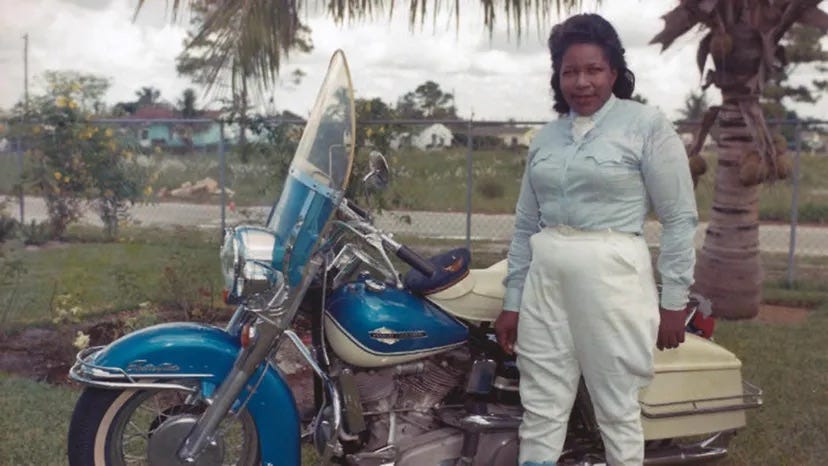Bessie Stringfield - The Black Woman Who Trekked Alone Across the US During the 1930s Jim Crow Era On A Harley-Davidson Motorcycle
Bessie Stringfield rode over a million miles of bad roads and highways in her six decades of riding Harley Davidson and Indian motorcycles. Stringfield trekked solo across the continental United States many times despite the Jim Crow laws of the 1930s and 40s. She encountered racism, bigotry and sexism throughout her expeditions. In an interview, Stringfield said: "If you had black skin, you couldn't get a place to stay. I knew the Lord would take care of me and he did. If I found black folks, I'd stay with them. If not I'd sleep at filling stations on my motorcycle." In later years she would also ride her way through Europe, Brazil and Haiti. The intrepid motorcyclist rode where she wanted to go without hesitation, relying on her skill, optimistic temperament and faith in God, "When I get on the motorcycle I put the man upstairs on the front.”
Born in North Carolina in 1911, Stringfield was only a teenager when she got her first motorcycle, a 1928 Indian Scout. She spent many hours learning to ride and control the motorcycle, eventually becoming quite good at handling the 700 pounds of steel. At the age of 19, a confident Stringfield, answering the call to adventure, decided to strike out on a journey of self-discovery. She flipped a penny onto a map of the United States to select her destination and then ventured out to tour the nation on her Indian Scout, alone.
Stringfield loved the freedom of the open road. She conquered the dusty roads and muddy highways of an American road system that was still rough and primitive, gaining skill with every obstacle that came her way. She became an expert mechanic, making her own repairs and keeping her motorcycle in top form. Bessie Stringfield was living her life freely, on her own terms, doing what she loved best, riding her motorcycle. “I’m very happy on two wheels.”
Stringfield became the first Black woman to ride a motorcycle in every one of the connected 48 states. Between the 1930s and her death in 1993, Stringfield wound up making eight solo trips across the United States.
She supported herself along the way by competing in races and performing motorcycle stunts at fairs. Stringfield performed in the dangerous, Wall of Death, where motorcyclists race at high speeds around the enclosed vertical wooden walls of a barrel-shaped arena. Stringfield also raced competitively on the flat-track circuit, once being denied prize money after removing her helmet and revealing she was a woman.
By the start of World War II, Stringfield had built a reputation as an experienced motorcyclist and racer. She was able to parlay these skills into a job with the United States government during the war as a civilian motorcycle dispatcher, the only woman in her unit. Riding her blue Harley-Davidson Knucklehead, now adorned with an official military crest, Stringfield was entrusted with transporting confidential documents between US military bases.
After the war, Stringfield bought a house in Miami, Florida where she studied and became a nurse. Still riding her motorcycle everywhere, she often caugh the attention of the local police. Stringfield related to American Motorcyclist magazine in 1996, that when she tried to obtain her motorcycle license, the police made it clear in no uncertain terms that they weren’t about to let a Black woman ride a motorcycle around their city. Unfazed after having experienced far worse encounters with racism on her journeys, Stringfield fought back. She demanded a meeting with the police captain in charge of the motorcycle unit in order to convince him to test her qualifications. The captain agreed and took her to a nearby park where Stringfield was asked to perform difficult motorcycle maneuvers beyond the usual testing. Awed by her skill and precision, the police captain relented and granted her the license. “From that day on, I didn’t have any trouble from the police.”
It didn’t take long for Stringfield to become well known to local residents who began to call her the “Motorcycle Queen of Miami.” She continued to race and perform at motorcycle shows and events throughout the Southeast and founded the Iron Horse Motorcycle Club, for women. According to the The Miami Herald, Stringfield would still ride her motorcycle around town and to church, well into her seventies. She rode right up until her death in 1993, despite her doctors suggestion that she do otherwise. “I told him if I don’t ride, I won’t live long. And so I never did quit.”
Wherever Stringfield would ride or make an appearance she drew attention. According to friend and biographer, Ann Ferrar, "Bessie's superpower was her ability to not focus on struggle, but rather in how she reacted to each situation and each individual.” The people of her community were proud of her and always pleased to see this independent Black woman riding her Harley through town, empowered and confident.
In 2000, The American Motorcycle Association, in acknowledgment of Bessie Stringfield as a transcendent American rider and trailblazer, established the "Bessie Stringfield Memorial Award" to recognize outstanding achievement by a female motorcyclist. Stringfield was inducted into the Motorcycle Hall of Fame in 2002.





